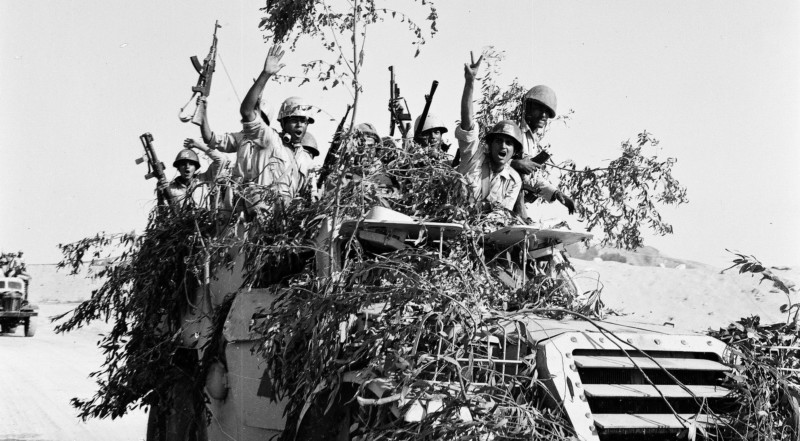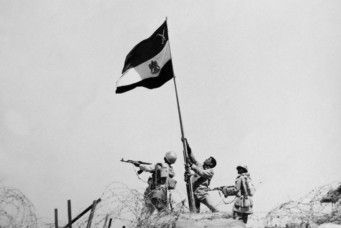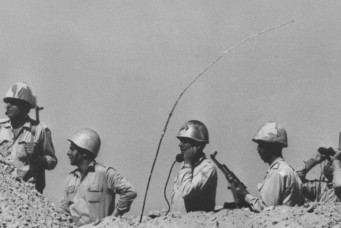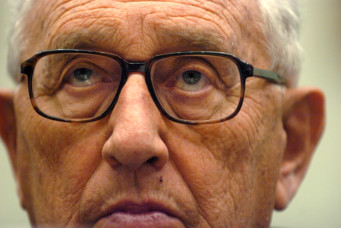October 1973: Memoires of a Soldier and Scholar
Reflections on how I experienced the war, first as a student-activist, then as a soldier, and later as a political scientist

Egyptian troops celebrate the end of the Battle of Ismailia, in which Israel launched a last-ditch effort to capture the city, Oct. 23, 1973. Deversoir, Egypt. Mohamed Lotfy/Ahram
It has been fifty years since the 1973 October War. Time has passed and the world has changed immensely since then. But to me and other members of my generation, that war was a turning point in our lives, not so much because of what happened in that great event, but because it was a major revolution that had simmered for six years, starting with the shocking defeat of the June 1967 War and culminating with the crossing of the Suez Canal on October 6, 1973.
The Anguish of Defeat
Perhaps the starting point of my journey was that long sixty-kilometer march we undertook on June 9-10, 1967—from Al-Bajour in Menoufiya governorate to Cairo—to call on Gamal Abdel Nasser to remain in power, after he said he would abdicate over the outcome of the Six-Day War. The defeat was resounding and degrading for the twelve young people, myself included, who took it upon themselves to make the point that the defeat was not the end of the story. We had hoped that the great leader of the time, Nasser, might find a way to pull through it as he did during the Suez Crisis of 1956. We may have been students of political science at Cairo University, required to bring some academic detachment to the study of domestic and international politics, but like all other youth at that moment, all we felt was profound anguish and distress at the disaster that had befallen Egypt. We poured into the squares of the capital in throngs, believing this was the only response to Israel’s aggression.
Our first order of business was to put Nasser back in power. After we felt that we succeeded in the glorious act of reinstalling the zaeem (the leader), we went back home, this time taking a bus. On that ride, we were deep in conversation, and it dawned on us that in the wake of war, that season’s cotton crop—a major Egyptian cash crop at the time—was neglected and would be severely damaged if left unattended. I was among a group who volunteered to rescue the cotton harvest that had almost been lost in the aftermath of the war. I then signed up for military training, which took place in Al-Dakhila near Alexandria. That was where I had my first brush with death. A bullet whistled by my face after having been fired by a colleague who had forgotten to take the necessary safety precautions.
After that, the academic year was about to begin. The Fall of 1967 began like no other before it. A pall of disappointment and grief had settled on the returning students. There was also a single and shared conviction that we could not accept what happened on June 5, 1967 and that this rejection needed to be associated with a process of evaluation and criticism. Nasser was no longer infallible. His fellow “Free Officers” were no longer automatically blameless. The whole of Egypt was not above reproach. The country had just experienced one of its most significant historical failures.
We continued to follow the news from the front closely. Then came International Students Day on February 21 1968 and along with it the court sentences doled out to Egyptian Air Force commanders alleged to have been responsible for the “setback” (the “setback” was a description penned by famed journalist Mohamed Hassanein Heikal to refer to the defeat). The commanders were tried in military tribunals. My colleagues and I gathered in the cafeteria of the Faculty of Law, which shared some buildings with the Faculty of Economics and Political Sciences. There we heard about the worker demonstrations, and from there we joined what became known as the first youth revolution in Egypt since the events of July 23, 1952 that transformed Egypt from a monarchy to a republic.
The 1952 revolution was not a revolution in the strict sense of the term. It was perceived as a “blessed movement” led by army officers set on ousting the British, who had overstayed their welcome since their occupation of Egypt in 1881. But the Free Officers Movement turned into a revolution that would spread its wings over the entire Arab region as it pursued industrialization and agricultural reform at home. The revolutionary fervor faded, apart from protest movements that arose in the aftermath of the 1967 defeat when university students took to the street to call for war against Israel. A revolution of a different sort erupted with the bread riots of January 17-19, 1977. That wave ultimately ended with the assassination of President Anwar Sadat by the Muslim Brotherhood because he had concluded a peace treaty to liberate Egyptian territory.
We wanted another war in order to take revenge. We wanted to bring officials to account for the crime that led to the defeat. Quite simply, we wanted another Egypt than the one that had been so remiss in its responsibilities that it was occupied twice in the space of two decades. Our revolution produced the March 30 Program that put-on record, for the first time in Nasser’s Egypt, that the situation in the country was not as it should be and that there was need for reform. The program did not go over well as it objected to the concept of the one-party state as epitomized by the Arab Socialist Union at the time. But the War of Attrition was set into motion and the cause of combat took precedence. I was recruited to the army on September 12, 1970.
The students’ revolution—or the youth revolution as we would call it today—persisted throughout all those years, reaching its peak in 1972 with the creation of the Supreme National Students’ Committee. The committee spearheaded a huge ten-day long strike that concluded with a sit-in at Cairo University’s main auditorium. Shortly after midnight, I returned home to put on my military uniform. My long leave to complete my university studies was over. At dawn, from the window of the bus as it passed in front of the Giza security directorate, I saw an amassment of police cars and Central Security Forces. I knew that the sit-in was being—or had already been—dispersed.
This does not mean that the student revolution was crushed. It would have taken a war to do that. It continued in various forms and the world stood amazed at the youth of Egypt while youth elsewhere had found their solution in the “love overcomes all” ideal that had taken root since 1968. We did not pay much attention to that revolution in our days. In fact, the divisions among us, between left and right, and the numerous subdivisions within those two camps, did not concern us greatly as long as we were all resolved on war.
As of the Spring of 1973, there was a noticeable pick up in the pace of preparations in our various regiments. I was now a chemical weapons monitor tasked with keeping abreast of the enemy’s use of chemical or nuclear weapons. In addition to my machine gun, I was equipped with two devices. In one you would insert a sample of soil or air and, if it changed color, you would know there had been a chemical weapons attack. The other device measured radioactive emissions.
This was not my only mission. Having completed training courses in the chemical warfare, army morale, and survey divisions, it was only natural that I would be brought on board the reconnaissance unit in the 654th anti-tank missile battalion that was commanded by Lieutenant Colonel Gamal Hafiz and whose operations were headed by Major Mohamed Abdel Wareth.
“War games” are military drills generally performed in military academies and by armed forces in various combat formations, to train soldiers for similar scenarios in actual combat. Often the exercises involve realistic simulations of such scenarios. In May and August 1973, when I was a recruit in the Egyptian Armed Forces, I personally bore witness to comprehensive simulations that would train us for the crossing of the Suez Canal. It turned out that they closely resembled what actually took place during the war that year.
War Is Coming
Mobilization operations on the front began on September 22, 1973. Although we had spent most of the year until then performing various maneuvers—or, for some of us, in demonstrations, one of which landed me in jail for three weeks—I felt there was something different this time. On the morning of September 28, Lieutenant Colonel Hafiz asked me to take a 36-hour leave. That was strange given the heightened maneuvers, but the prospect of a hot shower beckoned to me and I took the leave. I do not think that I have ever spent a 36-hour stretch more exciting than this one. I had that curious sensation that I was on the brink of a great event from which I had no way of knowing whether I would return alive or dead.
The rest of the day, on September 28, I spent with my sister: we even went to see The School of Misfits, a popular play by Ali Salem. The following morning, I went to Cairo University; it was the only place that remained a fixed base for the revolution and for the war drive for young students at the time. I met up with a group of revolutionary youth, among whom was my friend the late Mohamed Al-Sayed Said, Taha Abdel-Alim, Magdi Hussein, a Palestinian with his future Egyptian wife, and others. As always, when we met, we had quickly engaged in a heated discussion. I said that war was imminent and that it was the duty of each and every one of us to go to the front to take part in the event for which we had been campaigning for many years. There was a short dispute when one of the people there objected that the current regime did not have the ability to wage war, and even if it did, it would only be to serve “bourgeois” and colonialist interests. Therefore, it was not worth taking part in it. Said, my friend, interjected firmly, “But this is a patriotic war.” That put an end to the discussion.
That evening, Said and I returned to the front together on the same train, along with my friend Abdel-Moneim Al-Mashat. Later I would learn that this “leave” had been part of a strategy to deceive the enemy. On the morning of October 6, Lieutenant Colonel Hafiz told me that he was going to the headquarters of the 16th infantry division and that our battalion had been assigned to support, as its anti-tank arm might be assigned an important mission and that we might have to readjust the maps when he returns. He returned exactly an hour later, and this time his face bore the expression of a man who realized that a historic hour was at hand. The war was about to begin. At 1:00 pm, the troops would gather. At 2:00 pm, they would move into action.
The commander met with the unit commanders and then with the troops. He was very business-like. There was no impassioned speech or expression of patriotic fervor. We would engage in combat as we had practiced during our many previous maneuvers, only this time it was for real, and we would be armed with our training, patriotism, and faith. There was a reserve officer who erupted into a fury when he learned that he was to be leading the rear-guard of the brigade and would not be taking part in the Suez Canal crossing. “What am I going to say to my son when he learns that his father was in the army on the day of the crossing but didn’t cross?” he asked angrily. Some rearrangements were made so that he could accompany us. He fought valiantly, was wounded in battle, and returned a hero.
The command position of our brigade was situated a few kilometers away from the Suez Canal where our tank units were deployed on artificial ridges. From there we watched the planes soaring over the canal to launch the aerial strike after which around one thousand artillery guns began to fire. Our mission was to protect the units that crossed the canal from enemy counter-offensives. My task was to assist the head of operations by plotting the information I received on our maps. At precisely 8:00 pm, our units descended from the earthen ridges and moved towards the canal. As we approached, the head of operations rushed forward and then came back to bring me to the most wonderful sight in history. The pontoons had been locked into place from one bank to the other, and along the sides were a series of posts lit with red and blue lights. I stared at our unit’s pontoon bridge amazed. Sensing how overcome I was by emotion, my commander said, “Isn’t it as beautiful as Qasr Al-Nil Bridge at night?” Qasr Al-Nil Bridge was the byword for romance in those days.
The war unfolded through various phases, from the glory of the crossing to the pain over loss of life and equipment. But we also destroyed fifty-four enemy armored units, including forty tanks. In other words, we paid the enemy back twofold. From the ranks of our battalion, Sergeant Mohamed Sadek earned the Sinai Star for having taken out twenty Israeli tanks singlehandedly. Six conscripts also won medals.
What a splendid moment it was and how proud I felt to have been among those who fought under the command of Lieutenant Colonel Hafiz and Major Abdel Wareth. After the guns fell silent, the diplomatic battle was waged to secure the liberation of the occupied territory. When that succeeded, our youth revolution had reached its end, but perhaps revolution had begun for others in another form.
Looking Back as a Scholar
It must be five decades since I began researching why U.S. intelligence agencies failed to predict the two-pronged Egyptian-Syrian attack against Israel in 1973. The October War was the subject of my PhD thesis, and this aspect of my research naturally led me to study other cases featuring the element of surprise, which has long been a subject of interest to political scientists.
The war opened a road to finding a solution to the Arab-Israeli conflict. Egypt succeeded in regaining the occupied Sinai Peninsula; Syria regained some of its occupied territory; and the Palestinians, through organized resistance and popular uprisings, succeeded in creating the first Palestinian national governing authority on Palestinian land.
For seven decades, the Arab-Israeli conflict revolved around two variables: the creation of realties on the ground, and political, diplomatic, and military prowess. The result was the establishment of the state of Israel, its expansion beyond the borders set by the 1948 UN partition resolution, and its subsequent expansion after the 1967 War to an empire extending from the Jordan River to the Mediterranean and from Quneitra in Syria to Qantara east of the Suez Canal in Egypt.
The Arabs only began to tip the scales in the other direction following the war, which led to the shrinkage of the Israeli empire through the subtraction of Sinai, parts of Jordan, and bits of the Syrian Golan. Meanwhile, the Palestinians have remained unable to realize their dream of an independent state. They have achieved a “national authority” on Palestinian land for the first time in history. But that authority is weak and limited in resources and in power.
The October War effectively turned the conflict from an existential conflict to a non-existential one. In the beginning, Arab states were in complete denial of the legitimacy of the Israeli state. The conflict was about existence, not borders, as it was said. Israel, on the other hand, rejected the legitimacy of the Palestinian cause. The Jews were a people without a land, and they came to a land without people; so it was alleged. The war started the first serious processes to disengage the two parties from the conflict.
With the signing of the Israel–Egypt and Israel–Syria Disengagement Agreements, the conflict was no longer centered around the existential survival of either side, as key Arab states abandoned the Khartoum Summit’s “Three Nos” in favor of first steps toward eventual accommodation with Israel.
This was reflected particularly in Egypt’s decision to pursue peace with Israel. Egypt’s decision to reach an agreement with Israel was transformative and affected the entire region. In turn, Israel adopted a multi-faceted policy, making all the concessions required to reach a peace agreement with Egypt while pursuing an aggressive policy regarding Iraq’s nuclear program and the PLO’s presence in Lebanon.
In the realm of Arab-Israeli peacemaking, the most dramatic breakthrough in Arab willingness to make peace with Israel was the stunning visit by Egypt’s President Sadat to Israel in November 1977, a first-ever by an Arab leader to the state of Israel; the Camp David Accords, the agreement produced through the Egyptian-Israeli negotiations at Camp David in mid-1978; and the signing of a peace treaty between the two countries in March 1979.
It was through Camp David that the peace treaty, which brought an end to the Israeli occupation of Sinai in 1982, was finalized. Just over a decade later, another set of face-to-face meetings led to the Jordan–Israel Peace Treaty. In between came the Oslo Accords which established the first Palestinian national authority, creating an unprecedented reality on the ground in Palestine.
Sadat’s trip to Israel was preceded by a number of important but less dramatic positive developments in Egyptian-Israeli relations. The first was the Disengagement Agreement signed by the two countries on January 18, 1974. The second Egyptian–Israeli Disengagement Agreement, signed on September 1, 1975, allowed for further Israeli withdrawals.
Despite the success of the Camp David Summit, the road to signing the Egypt– Israel Peace Treaty was not easy. When the two sides resumed discussions in the summit’s aftermath, this time at Blair House on October 12, 1978, the talks ran into difficulties over the linkage between the proposed bilateral treaty and the issue of establishing autonomy for the Palestinians, as well as some aspects of the bilateral deal—notably the issue of oil supply for Israel and Egypt’s demand in return for early Israeli withdrawal.
On March 10-13, Carter visited Egypt and Israel to iron out the remaining differences. On March 19, the Israeli g government approved the text of the peace treaty, and on March 22, the Knesset approved it by a margin of 95 to 18 with five members/votes abstaining or absent. The Egyptian parliament unanimously approved the peace treaty with Israel on March 21, and on March 26, the treaty was signed at the White House.
As an important part of implementing its obligations under the peace treaty, Israel evacuated its settlements in Sinai in 1982. Eighteen settlements consisting of about seven thousand settlers were evacuated. Just prior to transferring the Sinai Peninsula to Egypt in April 1982, Yamit, the largest settlement with three thousand inhabitants, was evacuated after resistance by many of its settlers.
After Sadat was assassinated, his successor, Hosni Mubarak, kept Egyptian foreign policy on course. If the peace with Israel turned “cold” in the 1980s, this was not because Sadat was gone but because Israel refused to withdraw from Taba, bombed the nuclear reactor in Iraq, and invaded Lebanon in 1982. With the 1991 Madrid Peace Conference that led to the conclusion of the Oslo Accords, some warmth was restored to Egyptian-Israeli relations. The same applies to the Jordanian-Israeli peace agreement. That was unaffected by the death of King Hussein and the succession of his son, King Abdullah II. Nor did official Palestinian policy change significantly on the points of dispute and agreement with Israel with the transition from President Yasser Arafat to President Mahmoud Abbas. On the whole, Arab governments that were committed to the peace process remained so, even after major changes.
Complexity and Resilience
Although the October War has been a turning point in the Arab–Israeli conflict, both the conflict and the peace have proved to be resilient. As a result of the war, it was no longer plausible to refer to an “Arab-Israeli” conflict. The conflict now became centered around two parties, the Palestinians and the Israelis, as Arab countries started to face new internal political pressures and external geopolitical and geostrategic concerns. The “Arab Spring” was instrumental in changing the priorities of Arab countries to place much more emphasis on domestic issues and reform. As the trajectory of the Arab Spring devolved into a battle between Islamists of different sorts, the “core Arab issue” of Palestine lost its centrality. The growing threats and pressures of Iran, Turkey, and Ethiopia on the security of the Gulf and water supplies to Syria, Iraq, the Gulf countries, and Egypt have made the Israeli and Palestinian crisis less threatening. In fact, the gates became open for different types of cooperation including in the realm of defense and security.
However, inside both Israeli and Palestinian societies, a sharp turn to the religious right has deeply complicated the domestic politics of each and has driven both polities away from peace.
Yet, Arab–Israeli peace not only proved to be resilient but has expanded to take the form of the Abraham agreements between Israel and another four Arab States—the UAE, Bahrain, Sudan, and Morocco—that involved recognition and normalization. Although there is no sign of warming in the relations between Israel on one hand and Egypt and Jordan on the other, engagements between them are growing on national security and energy interests. The formation of the East Mediterranean Gas Forum has been a step forward for the Israelis, the Palestinians, the Jordanians, and the Egyptians. About five Gaza wars between 2008 and 2023 have inflamed the Palestinian–Israeli conflict, but the continuation of different types of cooperation has been possible.
At the time of writing this article, efforts by the United States have concentrated on peacemaking and normalization between Israel and Saudi Arabia. The ideas coming out of the political interactions reflect a grand project that affects not only relationships but also the peaceful use of nuclear energy and regional security. A possible deal might also affect the internal configurations of power within both Palestinian and Israeli body politics.
The legacy of the 1973 War on conflict and peacemaking is still the call of the day. The resilience and complexity of a very protracted conflict is the result of a process that requires fortitude and resistance. What is becoming clear for all the parties is that they are on their own. Deepening their bilateral relations can address their own dilemmas and perhaps move the Israeli-Palestinian conflict closer to resolution.
Abdel Monem Said Aly is chairman of Al-Masry Al-Youm Publishing House and a senior fellow at the Crown Center for Middle East Studies at Brandeis University. He was chairman of Al-Ahram Newspaper and Publishing House between 2009 and 2011, and director of Al-Ahram Center for Political & Strategic Studies from 1994–2009. He is the author of State and Revolution in Egypt: The Paradox of Change and Politics, and co-author of Arabs and Israelis: Conflict and Peacemaking in the Middle East.
Read More



